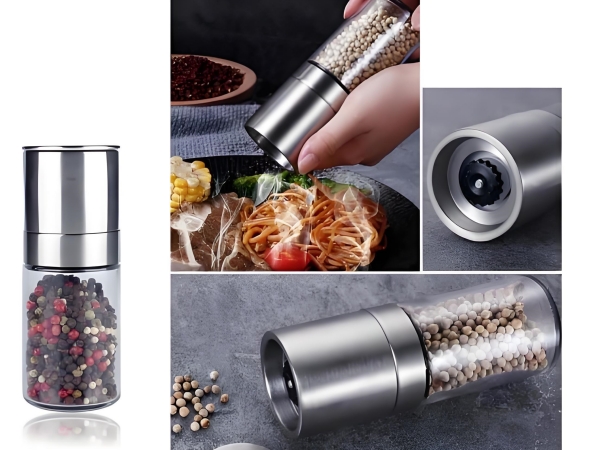Stainless steel has earned its place in kitchenware for good reason. Unlike regular steel, it boasts a unique composition that fends off moisture and oxidation – two main culprits behind rust. For anyone who values both functionality and aesthetics, the stainless steel salt pepper mill offers a winning combination: it resists fingerprints, complements most kitchen decors, and promises to withstand the hustle of daily cooking.
Yet, many users have encountered unexpected rust spots on their stainless steel grinders, leaving them wondering if the “rust-proof” claim is too good to be true. The answer lies in understanding how stainless steel works, its limitations, and how proper care can maximize its rust-resistant properties. Whether you’re shopping for a new pepper mill or looking to protect your existing one, this article will clear up the confusion and help you make informed decisions.
Stainless steel’s corrosion resistance isn’t magic – it’s chemistry. At the core of its durability is chromium, a metal that makes up 10.5% or more of stainless steel’s composition. When exposed to oxygen, chromium forms a thin, invisible layer of chromium oxide on the surface. This passive layer acts as a shield, blocking moisture and air from reaching the underlying steel and preventing rust formation.
But this shield isn’t indestructible. If the chromium oxide layer is damaged or compromised, the stainless steel becomes vulnerable. Scratches from harsh cleaning tools, exposure to highly acidic or alkaline substances, or prolonged contact with standing water can break down this protective barrier. When that happens, rust (iron oxide) can start to form, especially if the stainless steel salt pepper mill is made with lower-grade stainless steel that has less chromium.
It’s also important to note that “stainless” doesn’t mean “immune to all corrosion.” In extremely humid environments or when in contact with corrosive agents like salt (more on that later), even high-quality stainless steel may show signs of discoloration or rust over time – especially if not properly maintained.
While stainless steel is designed to resist rust, several common scenarios can lead to corrosion in stainless steel salt pepper mills. Being aware of these triggers can help you avoid costly damage and extend the life of your grinder.
With the right care, you can keep your stainless steel salt pepper mill rust-free and functioning smoothly. These simple, actionable tips target the root causes of rust and help preserve the stainless steel’s protective layer.
When shopping for a pepper mill, you’ll often choose between stainless steel and ceramic grinding mechanisms. Both have their merits, but when it comes to rust resistance, the difference is clear – and it’s not just about the mechanism itself, but the material of the mill’s body.
Not all stainless steel salt pepper mills are created equal. To ensure you’re getting a rust-resistant, high-quality product, keep these key factors in mind during your search.
Yes, you can grind salt in a stainless steel pepper mill, but it’s not ideal for long-term use. Salt’s corrosive properties will accelerate wear and increase the risk of rust. If you prefer a combined mill, choose one with a separate salt compartment that has a ceramic lining or mechanism to protect the stainless steel.
Clean your stainless steel salt pepper mill every 2–4 weeks, or more frequently if you use it daily or grind salt in it. Regular cleaning removes salt residue, moisture, and spice dust that can promote corrosion.
If you spot small rust spots, mix equal parts baking soda and water to make a paste. Gently scrub the rust with a soft cloth or toothbrush, then rinse and dry thoroughly. For larger rust patches, use a stainless steel cleaner (avoid abrasive products). If the rust has spread to the grinding mechanism, it may be time to replace the mill.
Yes, a stainless steel pepper mill is generally more durable than a ceramic one. Stainless steel resists impact, doesn’t chip or crack, and can handle hard spices without damage. Ceramic mills are prone to breakage if dropped or used with coarse spices, making stainless steel a better choice for busy kitchens.
The stainless steel salt pepper mill is a durable, stylish addition to any kitchen – but it’s not entirely rust-proof. Its rust resistance depends on the quality of the stainless steel, how it’s used, and how well it’s maintained. By understanding the science behind stainless steel’s corrosion resistance, avoiding common rust triggers, and following proper care tips, you can keep your pepper mill rust-free for years.
When shopping, prioritize high-grade stainless steel (304 or 316), sealed mechanisms, and reputable brands. For maximum rust protection, consider separate mills for salt and pepper, and always hand-wash and dry your grinder thoroughly. With the right product and a little care, you can enjoy fresh, flavorful seasoning without worrying about rust ruining your kitchen essential.

Contact: Silvia Chan
Phone: +86 15105193797
Tel: +86 17302548247
Email: sales@fet-grinder.com
Add: Xinghuo Road 19,Pukou District, Nanjing City , Jiangsu Province ,China